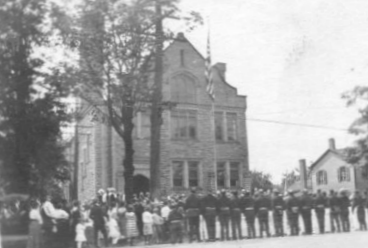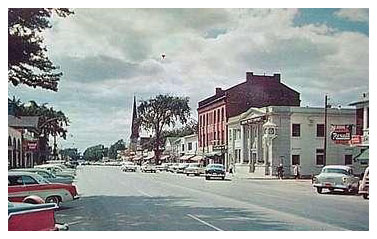Village
of Williamsville Code
Previous Chapter | Table of Contents | Next Chapter
ARTICLE III
General Provisions
§ 31-3. Lands to which
chapter applies.
This chapter shall apply
to all areas of special flood hazards within the jurisdiction of the Village
of Williamsville.
§ 31-4. Basis for establishing
areas of special flood hazards.
[Amended 8-26-1991 by L.L.
No. 7-1991; 5-13-1996 by L.L. No. 1-1996]
A. The areas of special
flood hazard are identified and defined on the following documents prepared
by the Federal Emergency Management Agency:
(1) Flood Insurance Rate
Map (single panel) No. 360263, whose effective date is March 1,1982.
(2) A scientific and
engineering report entitled
"Flood Insurance Study,
Village of Williamsville, New York, Erie County," dated September 1,1981.
(3) Flood Boundary and
Floodway Map (single panel)
No. 360263, whose effective
date is March 1,1982.
(4) Letter of Map Revision
effective May 8, 1996, as
FEMA Case #95-02-037P and incorporating a revised hydraulic analysis for
Ellicott Creek affecting panel 0015.
B. The above documents
are hereby adopted and declared to be a part of this Local Law; The Flood
Insurance Study and/or maps are on file at: the Williamsville Village offices,
5565 Main Street, Williamsville, New York.
§ 31-5. Interpretation.
A. This chapter is adopted
in response to revisions to the National Flood Insurance Program effective
October 1, 1986, and shall supersede all previous laws adopted for the
purpose of establishing and maintaining eligibility for flood insurance.
B. In their interpretation
and application, the provisions of this chapter shall be held to be minimum
requirements adopted for the promotion of the public health, safety and
welfare.
C. Whenever the requirements
of this chapter are at variance with the requirements of any other lawfully
adopted rules, regulations or ordinances, the most restrictive or that
imposing the higher standards shall govern.
§ 31-6. Penalties for
offenses.
No structure shall hear
be constructed, located, extended, converted or altered and no land shall
be excavated or filled without full compliance with the terms of this chapter
and any other applicable regulations. Any infraction of the provisions
of this chapter by failure to comply with any of its requirements, including
icons of conditions and safeguards established in connection with conditions
of the permit, shall constitute a violation. Any person who violates this
chapter or fails to comply with any of its requirements shall, upon conviction
thereof, be fined no more than two hundred fifty dollars ($250.) or imprisoned
for not more than fifteen (15) days, or both Each day of noncompliance
shall be considered a separate offense Nothing herein contained shall prevent
the Village of Williamsville from taking such other lawful action as necessary
to prevent or remedy an infraction. Any structure found not compliant with
the requirements of this chapter for which the developer and/or owner has
not applied for and received an approved variance under Article VI will
be declared noncompliant and notification sent to the Federal Emergency
Management Agency.
§ 31-7. Warning and
disclaimer of liability.
The degree of flood protection
required by this chapter is considered reasonable for regulatory pub and
is based on scientific and engineering considerations. Larger floods can
and will occur on rare occasions. Flood heights may be increased by man-made
or natural causes. This chapter does not imply that land outside the area
of special flood or uses permitted within such areas will be free from
flooding or flood damages. This chapter shall not create liability on the
part of the Village of Williamsville, any officer employee thereof or the
Federal Emergency Management Agency in any flood damages that result from
reliance on this chapter or a administrative decision lawfully made thereunder.
ARTICLE IV
Administration
§ 31-8. Designation
of local administrator.
[Editor's Note: Amended
at time of adoption of Code; see Ch. 1, General Provisions Art.]
The Village Building
Inspector is hereby appointed local administrator to administer and implement
this chapter by granting or denying development permits in accordance with
its provisions.
§ 31-9. Development
permit required.
A development permit shall
be obtained before the start of construction or any other development within
the area of special flood hazard as established in § 31-4. Application
for a development permit shall be made on forms furnished by the local
administrator and may include, but not be limited to: plans, in duplicate,
drawn to scale and showing the nature, location, dimensions and elevations
of the area in question; existing or proposed structures, fill, storage
of materials, drainage facilities, and the location of the foregoing.
A. Application stage.
The following information is required where applicable:
(1) Elevation, in relation
to mean sea level, of the proposed lowest floor, including basement or
cellar, of all structures.
(2) Elevation, in relation
to mean sea level, to which any nonresidential structure will be floodproofed.
(3) When required, a
certificate from a licensed professional engineer or architect that the
utility floodproofing will meet the criteria in § 31-11C(1).
(4) Certificate from
a licensed professional engineer or architect that the nonresidential floodproofed
structure will meet the floodproofing criteria in § 31-12.
(5) Description of the
extent to which any watercourse will be altered or relocated as a result
of proposed development.
B. Construction stage.
Upon placement of the lowest floor or floodproofing by whatever means,
it shall be the duty of the permit holder to submit to the local administrator
a certificate of the elevation of the lowest floor or floodproofed elevation
in relation to mean sea level. The elevation certificate shall be prepared
by or under the direct supervision of a licensed land surveyor or professional
engineer and certified by same. When floodproofing is utilized for a particular
building, the floodproofing certificate shall be prepared by or under the
direct supervision of a licensed professional engineer or architect and
certified by same. Any further work undertaken prior to submission and
approval of the certification shall be at the permit holder's risk. The
local administrator shall review all data submitted. Deficiencies detected
shall be cause to issue a stop-work order for the project unless immediately
corrected.
§ 31-10. Duties and
responsibilities of local administrators.
Duties of the local administrator
shall include, but not be limited to:
A. Permit application
review. He shall:
(1) Review all development
permit applications to determine that the requirements of this chapter
have been satisfied.
(2) Review all development
permit applications to determine that all nay permits have been obtained
from those federal, state or local governmental agencies from which prior
approval is required.
(3) Review all development
permit applications to determine if the proposed development adversely
affects the area of special flood hazard. For the purposes of this chapter
"adversely affects" means physical damage to adjacent properties. An engineering
study may be required of the applicant for this purpose.
(a) If there is no adverse
effect, then the permit shall b granted consistent with the provisions
of this chapter.
(b) If there is an adverse
effect, then flood damage mitigation measures shall be made a condition
of the permit.
(4) Review all development
permit applications for compliance with the provisions of § 31-11E,
Encroachments. [Editor's Note: Amended at time of adoption of Code; see
Ch. 1, General Provisions, Art. I.]
B. Information to be
obtained and maintained. He shall:
(1) Obtain and record
the actual elevation, in relation to mean sea level, of the lowest floor,
including basement or cellar, of all new or substantially improved structures,
and whether or not the structure contains a basement or cellar.
(2) For all new or substantially
improved. floodproofed structures:
(a) Obtain and record
the actual elevation, in relation to mean sea level, to which the structure
has been floodproofed; and
(b) Maintain the floodproofing
certifications required in §§ 31-11 and 31-12.
(3) Maintain for public
inspection all records pertaining to the provisions of this chapter, including
variances when granted and certificates of compliance.
C. Alteration of watercourses.
He shall:
(1) Notify adjacent communities
and the New York State Department of Environmental Conservation prior to
any alteration or relocation of a watercourse and submit evidence of such
notification to the Regional Director, Federal Emergency Management Agency.
(2) Require that maintenance
be provided within the altered or relocated portion of said watercourse
so that the flood capacity is not diminished.
D. Interpretation of
FIRM boundaries.
(1) The local administrator
shall have the authority to make interpretations when there appears to
be a conflict between
the limits of the federally identified area of special flood hazard and
actual field conditions,
(2) Base flood elevation
data established pursuant to § 31-4, when available, shall be used
to accurately delineate the area of special flood hazards.
(3) The local administrator
shall use flood information from any other authoritative source, including
historical data, to establish the limits of the area of special flood hazards
when base flood elevations are not available.
E. Stop-work orders.
(1) All floodplain development
found ongoing without an approved permit shall be subject to the issuance
of a stop work order by the local administrator. Disregard of a stop-work
order shall be subject to the penalties described in § 31-6.
(2) All floodplain development
found noncompliant with the provisions of this chapter and/or the conditions
of the approved permit shall be subject to the issuance of a stop-work
order by the local administrator. Disregard of a stop-work order shall
be subject to the penalties described in § 31-6.
F. Inspections. The local
administrator and/or the developer's engineer or architect shall make periodic
inspections at appropriate times throughout the period of construction
in order to monitor compliance with permit conditions and enable said inspector
to certify that the development is in compliance with the requirements
of either the development permit or the approved variance.
G. Certificate of compliance.
(1) It shall be unlawful
to use or occupy or to permit the
or occupancy of any building
or premises, or both, ore thereof bear created, erected, changed, converted
wholly or partly altered or enlarged in its use structure until a certificate
of compliance has been issued by the local administrator stating that the
building or land conforms to the requirements of this chapter.
(2) All other development
occurring within the designated flu hazard area will have, upon completion,
a certificate of compliance issued by the local administrator.
(3) All certifications
shall be based upon the inspections conducted subject to Subsection F and/or
any certified elevations, hydraulic information, floodproofing, anchoring
requirements or encroachment analysis which may have been required as a
condition of the approved permit.
ARTICLE V
Provisions for Flood Hazard Reduction
Previous Chapter | TOP | Table of Contents | ARTICLE V

|
A picture of 5583 Main St Village Hall pictured in 1949 was originally built with limestone mined from the Young's limestone quarry which occupied what is now The Country Club of Buffalo. click here to see a bigger picture.
|

|
A picture of Main St looking West taken in 1950. The Ronecker building on the right is now home to Marty's formal wear. Picture courtesy of Dan Crapsi. click here to see a bigger picture.
|
Click Here to see more pictures
 |
 |



